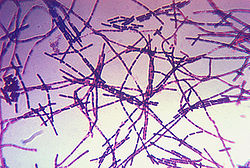Caryophanales
| Caryophanales | ||||||||
|---|---|---|---|---|---|---|---|---|
 | ||||||||
| Systematik | ||||||||
| ||||||||
| Wissenschaftlicher Name | ||||||||
| Caryophanales | ||||||||
| Peshkoff 1939 |
Caryophanales, auch als Bacillales bezeichnet,[1] bilden eine Ordnung grampositiver Bakterien aus der Klasse der Bacilli. Namensgebend für die Bacillales war die Gattung Bacillus aus der Familie Bacillaceae.
Viele dieser meist stäbchenförmigen Bakterien sind aerob, sie können nicht unter Sauerstoffausschluss leben. Ein wichtiges Merkmal vieler Vertreter ist die Fähigkeit, unter ungünstigen Bedingungen (z. B. Nahrungsmangel oder Temperatur) Endosporen zu bilden.
Systematik
Folgende Familien werden der Ordnung Caryophanales zugeordnet (Stand 19. April 2022):[2]
- Alicyclobacillaceae
- Bacillaceae
- Caryophanaceae
- Desulfuribacillaceae
- Listeriaceae
- Paenibacillaceae
- Pasteuriaceae
- Planococcaceae
- Sporolactobacillaceae
- Staphylococcaceae
- Thermoactinomycetaceae
Quellen
- ↑ Jean Euzéby, Aidan C. Parte: Order Caryophanales. In: List of Prokaryotic names with Standing in Nomenclature (LPSN). Abgerufen am 11. Juli 2018.
- ↑ Jean Euzéby, Aidan C. Parte: Order Bacillales. In: List of Prokaryotic names with Standing in Nomenclature (LPSN). Abgerufen am 19. April 2022.
Literatur
- George M. Garrity u. a.: Taxonomic Outline of the Prokaryotes. Bergey’s Manual of Systematic Bacteriology. 2. Auflage, Release 5.0, Springer-Verlag, New York 2004.
- Fritze, D. 2004. Taxonomy of the genus Bacillus and related genera: The aerobic endospore-forming bacteria. In: Phytopathology, Band 94, S. 1245–1248.
Weblinks
Auf dieser Seite verwendete Medien
Zellen des Bacillus anthracis.
